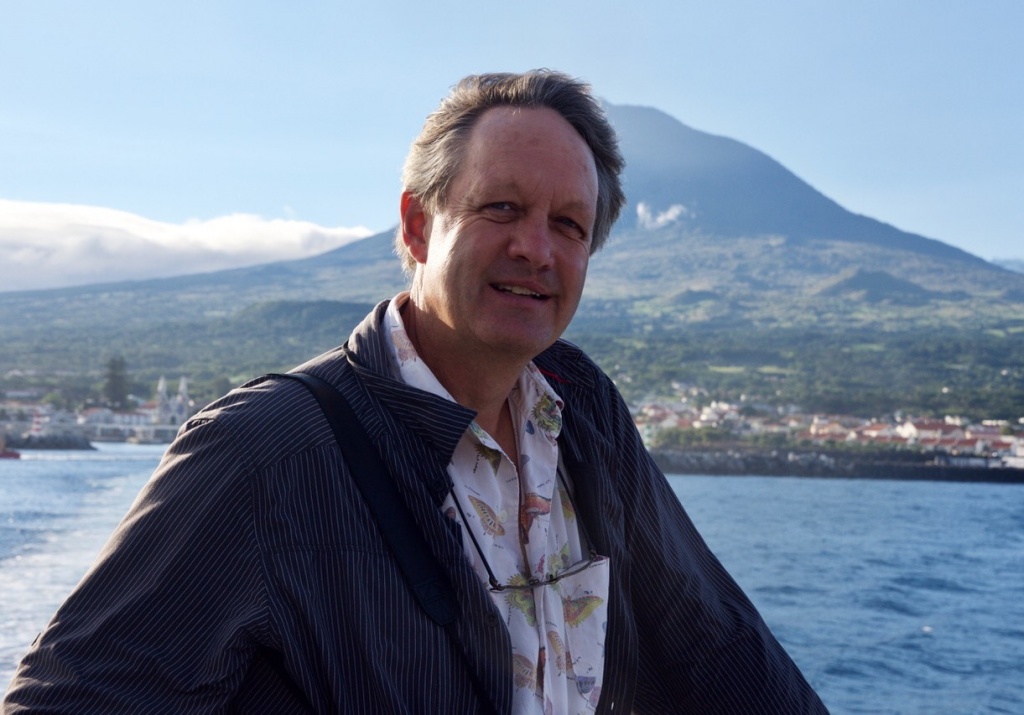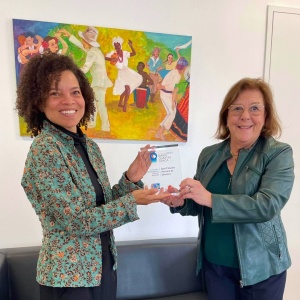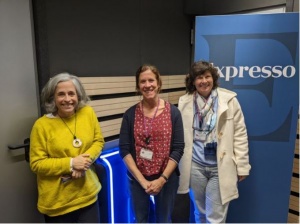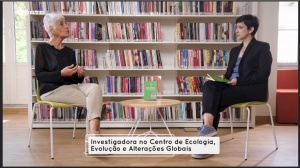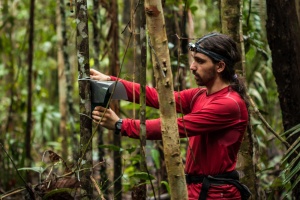6/10/2016. Interview by Marta Daniela Santos. Photo by Rosemary Gillespie.
Do you think it is impossible to create a detailed digital replica of an island’s entire ecosystem? Well, think again. The Island Digital Ecosystem Avatars (IDEA) Project is assembling an international group of researchers to recreate the entire ecosystem of Moorea, an island of volcanic origin in French Polynesia and one of the most studied ecosystems in the world.
George Roderick (UC Berkeley, USA) is currently working on the IDEA Project, which allows him to pursue his research interests in biological invasions, the history and structure of populations and sustainability and global change. But this is only one among his several research projects, which take advantage of the opportunities associated with the geography of Pacific Basin, Pacific Islands and Pacific Rim, including California:
You're currently working on an ambitious research project, that at a first impression can almost seem like science fiction: the idea of being able to recreate in a virtual way the whole ecosystem of an island. Can you please explain what is an island avatar and how did this idea first come up?
As you know on Earth we’re faced with many challenges, especially having to do with global change and globalization. Some of these are related to positive developments related to human well-being. But, associated with that, changes are happening: in temperature, sea level rise, ocean acidification, land use, CO2 in the atmosphere...all kinds of things. And it’s hard to get a handle on how these are connected, what factors contribute to these changes and what can we do about them.
Islands are well-defined ecosystems, and typically there's a lot of work on them by researchers with a very place-based focus, who are approaching different problems. Moorea is one of these places, where people work in coral reefs, anthropology, agriculture, medical health-related things... Because islands are well-defined, it's a small group of people who run into each other all the time, and it's a perfect place to think about connections between disciplines.
The idea is also to understand how what's happening in these different ecosystems is affecting other ecosystems. For example: how does what happens in the coral reef ecosystem affect how people live? How do climate change and changes in land use affect the people? And how does that affect the run-off that eventually ends up in the ocean and affect the coral reef? On islands, like any microcosm, you have the chance to model these interactions and figure out how they are connected. I agree it sounds ambitious. The name [of the project, IDEA] is somewhat catchy, I suppose, but it does convey this idea that it is a representation of the connections between these different disciplines. We can't do everything, but we're trying at least to understand how what happens in the terrestrial ecosystem affects the marine ecosystem and vice-versa, how what happens in nature affects the society, and so on.
And what makes islands the best models for this is their confinement, right?
Yes. Well...in fact at this meeting we had a big argument with physicists about whether islands are closed or open systems. For example, you think of earth as open with respect to energy, because the [energy from the] Sun comes in and heat goes out, and pretty much closed with respect to matter, because except for satellites and meteors there's not a lot of movement in matter. So, similarly, we finally decided that yes, islands are open in the sense that they are connected to the real world, but they are somewhat confined and certainly their flow of materials is limited.
Another thing is that islands tend to collect in the same location people who are approaching different questions and doing different kinds of work. All these people, whether they are astrophysicists, climate change biologists or anthropologists, they are all interested in what happens on that island. And Moorea isn't unique in that regard. Hawaii, the Canaries, the Azores, and so on, in any of these locations there is a lot of focus-based work going on.
Another cool thing about islands is that they're small, which means that you can describe all the species. And there is a limited number of people, so the economists involved think they can actually make a model where they incorporate the activities of every single person. On Moorea they're 17 000 people, and many islands are even smaller.
When we go to the project's website, at a first glance the Moorea avatar almost seems like a Google Earth representation. But it has another dimension - time. So, how does the website work, what can we find?
To start with, it allows you to fly over Moorea. They took images from a couple of satellites so they could recreate the three-dimensional idea, and they sort of modelled all the houses and even some of the trees, things like that. As for the coral reefs, they flew over with drones and used other kinds of sensing to try to get some understanding of the ocean depth.
So, part of that is just to have a platform where you can connect observations spatially. And then you can look at that over time. But the real point of the website is to bring together people who are studying different things in different ways. We haven’t realized that yet, it’s not complete, but at least it’s a start to get people who otherwise wouldn’t talk to each other, in science or social sciences, to interact.
So it's an ongoing project, with a lot of work ahead.
Yes. And we're still looking for really large funding. The idea and the things we have done so far are based on grants that people had for their own research, or smaller contributions. The project really isn't funded yet and that's something we are working on.
I should say we're not the only ones to do this kind of thing. There are a lot of places, like the Azores and Hawaii, where there are sets of researchers that are working together with similar purposes. I think that in terms of our research and student career and opportunities there is a lot to be said for understanding the connections between different disciplines, and especially between science and the humanities. These are disciplines that have very different cultures, and they go about finding the truth in different ways. We don't even have the same language to communicate what we do. So I think there is a real chance here: when different kinds of people are focused on one place and they care about it, it makes it easier for them to communicate. That’s a big challenge.
The other big challenge is communicating with the public. I think that we as researchers are really the ones with knowledge to provide solutions, and to do that we need to communicate with people that don’t have our training and speak a different language.
You also work with the local people. Do you notice that the project has an impact on them? Do they become more concerned about biodiversity conservation, for example?
Yes... I know mostly about the people of Polynesia, but this is probably true for people who live on islands everywhere. Their livelihoods are very dependent on what happens on the terrestrial and marine ecosystems. Everyday they're fishing, or farming or dealing with tourism, so they're very connected to what's happening in the real world and they have a very strong interest in this.
Also, I think that science has gone one direction and the cultural understanding of the environment has gone in another, and only recently there have been attempts for scientists to do outreach and to really listen to the people who have generations of understanding of these organisms and environments.
For example, we had a school project on Moorea called the EthnoCode, in which the school kids identified plants that were important for their environment and had to do a report on it. They came to the research station and talked about it, and DNA was gathered from the plants and put into an already existing database, with all the other organisms from Moorea.
There are also projects where the local people come and talk about their observations and how they view these organisms with the scientists. We had a big outbreak of Acanthaster planci, which is a big seastar that was eating up the corals. There was a lot of concern, but it turns out that these outbreaks happen every 25 or 30 years. People get very worried about it, but eventually it goes away. The local people and the community had some experience with this in the past, in fact they could even identify when an outbreak last occurred, so they were not as concerned. And that's just one example.
On many islands there is a set of marine protected areas where people can't fish, and creating those takes a lot of interaction with the local people, because they're giving us immediate resources for potentially better resources in the future. So understanding that, and making that work, takes a lot of interaction.
I read that in Moorea there are more alien or introduced plant species than native species. Is this always the case, in other islands and groups of islands?
It's not always the case: a lot of it has to do with the extent to which there are urban areas and agriculture. Another big factor is the extent to which islands were colonized by people. At the lower elevations, on most of the islands in the Pacific (including Hawaii) all the vegetation is largely introduced. Before the Europeans came there were lots of people on most of these islands, and they had a big impact on the vegetation and the ecosystem in the lower elevations; not so much in the upper elevations, which were harder to get to - but also, you couldn't easily farm them.
In fact, they had these tapus - tapu is a Polynesian word [the English word taboo derives from it] - for not going into the mountains, especially at night.
Anyway, at the lower elevations the vegetation on all these islands looks the same: very pretty, but exotic (introduced) - it comes from elsewhere. Some things, like coconut, have probably been there naturally, but many of the plants have been introduced. We don't really have a good handle on what the low land vegetation biota was before people came to the islands, although there are some projects where anthropologists are digging in the ground to find deposits of seeds and animal parts below the level where humans first came. When humans came there is a signature of carbon: there's a lot of burning, and they see organisms like rats and chicken - that were introduced by humans - and different kinds of fish, because people were throwing fish bones around after they ate them. But below that, you can find seeds and native organisms. And then in some caves there are bird parts, so for some of these groups we have a pretty good idea of the organisms that were there before humans.
On this point, there was a study done by Dov Sax, looking at many islands in the world, that found that for plant species there were more exotic introductions of plants than there had been naturally. And for bird species it was about equal. Many of these islands have a biota that is largely introduced as well as native. And in the marine system there are far fewer endemic marine organisms proportionally, compared to the terrestrial system – the level of endemism (species found nowhere else) is much lower in marine systems. But even in marine systems there are a lot of introduced species, like different kinds of algae. So introduced species are a big deal.
And I imagine that on islands the impact of these introduced species is greater.
Yes, people debate that. Daniel Simberloff has written papers about whether the impact is, in fact, greater or not. Certainly I think we see the impact more easily, because there are lots of people who are observing these things and there are fewer species on islands. But he and others have argued that the impact could be just as great elsewhere. In any case there is definitely a great impact of invasive species on islands, and it's easy to observe and measure.
To summarize: which lessons can we draw from islands to live more sustainably?
I think the first is that everything is connected. And we see this on islands very plainly. It may be that in continental systems the ecological, social and cultural connections are more complex, but...everything is connected, in ways that we are really just beginning to understand. So when there is more or less fishing…that affects the economy. And when people get sick, that affects how much they are fishing…all these things are connected. When we are flying in airplanes, when we are choosing to eat certain kinds of food, whether you are choosing to eat meat, or vegetables, all these decisions have an impact on Earth.
The second thing is that we can learn from islands that it is not a lost cause to think about climate change and addressing world problems. We can see on islands that when we create marine protected areas, for example, the fisheries come back. When people set up reserves and keep ungulates and pigs out of areas, the ecosystems recover. So, I think we can take from this research a message of hope, that we can have an impact. Maybe on islands we see it more easily, maybe it happens in weeks and months, not a lifetime, but I think it does provide these lessons to the public that it is possible to change the trajectory of what we’re doing.
And I think the third thing is that islands are permanently under stress. There’s sea level rise, climate change, the way of people’s livelihoods is being impacted, effects of globalization, invasive species…and so on.
Everything’s connected, islands give us hope for being able to change things in the future, and islands are in serious trouble. They are systems that need more efforts on conservation.
George Roderick was plenary speaker of the international congress Island Biology 2016, organized by the Azorean Biodiversity Group - cE3c.
Tags: IBBC

